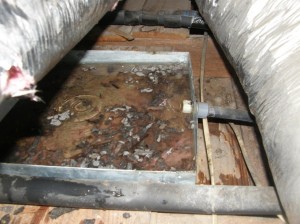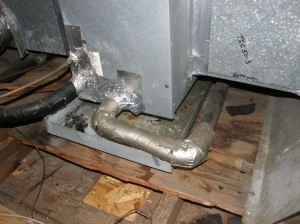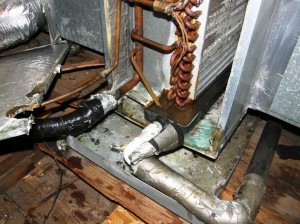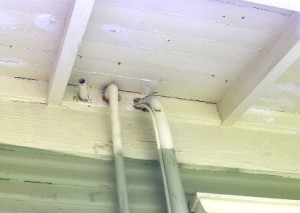Dripping A/C Line on Old Houses
Well, it’s true. A little bit of knowledge is dangerous. I just proved it again with a dripping A/C line.
As a realtor I’ve seen a lot of dripping A/C condensate lines. That’s the little PVC pipe sticking out of the eave of your house (Photo #4). Normally it doesn’t drip. When it does drip, it means you need to call you’re A/C guy ASAP, or go up in your attic and clean the line yourself. I’m surprised at the number of dripping lines I’ve seen and the owners don’t know there is a problem.
This is the way it works. Your central A/C evaporator is in the attic. (The condenser/compressor is outside, on the ground.) This evaporator wrings a LOT of moisture out of the air which drips down to an internal pan and flows out a pipe. You will never see this pan unless you open the unit in your attic. You also never see this line because typically it goes into a sewer line in the attic. On most old houses where A/C was retro-fitted (like mine) this line may just run outside somewhere.

#2 Don’t let your A/C condenaste pan fill up with dirt, dust, trash.If it overflows, it goes onto your ceiling.
However, unless you have your A/C serviced, this drain line will plug with dust and mold. When this happens it overflows out of the pan, into the evaporator housing, and eventually leaks out somewhere into the emergency overflow pan. Thus, when it overflows (not “if” it overflows) it runs into this second pan; out a PVC pipe; and you see the dripping at the eave of the house. This pipe is supposed to be over a window, so even if you never go outside, you’ll wonder what that dripping is. Photo #3 shows the tiny plastic pan filled to overflowing because of the plugged line. It runs over into the box and seeps out of seems to the overflow pan.
Do NOT let this drip for long. This is strictly an emergency pan. It is not to be left forever. Ideally, this pan catches the overflow; drips where you can see it immediately and you take care of it. If this pan overflows as mine nearly did. At this point the water just spreads out all over the attic until you get big, ugly brownish bulges in your ceiling and your light fixtures drip water.
I helped my ex-wife with a dripping ceiling a few years ago. I don’t remember which was worse; cleaning out the line; or repairing that old “popcorn” ceiling.
I see a lot of old houses. I think there are more ugly brown stains and ceiling patches from A/C leaks than there are from roof leaks.
Anyway, back to the little bit of knowledge….. I saw the dripping pipe on my house, but waited a week before going up in attic and dealing with it. It had a big secondary pan, I wasn’t worried. I knew I had time to take care of it. Well, I should have been worried. That pan was FULL of crap! I had recently had the roof replaced, so the pan was full of insulation, sawdust, pieces of shingles, dust and dirt. This pan was full to the brim and its drain pipe was stuffed full. Photo #3 shows this pan after i drained most of the water. It was FULL to the edge. I was just lucky it hadn’t already overflowed.
My second mistake was thinking that I could clean this out myself quickly. Three hours later it was done. I recommend this on a 98 degree day for quick weight loss.
So, the moral of the story: If you see that line dripping, go up in the attic and look at it, then call your A/C guy. If you are a DIY’er, you can clean it yourself, but it’s not a pleasant place to work.
I probably made this very confusing, I’ll stick to writing about houses in the future.
So, if you have an A/C question, don’t call me. But if you are considering buying or selling an old house and have questions, do call Houston Heights Realtor Rich Martin. I specialize in Houston Heights homes and the surrounding older neighborhoods.














